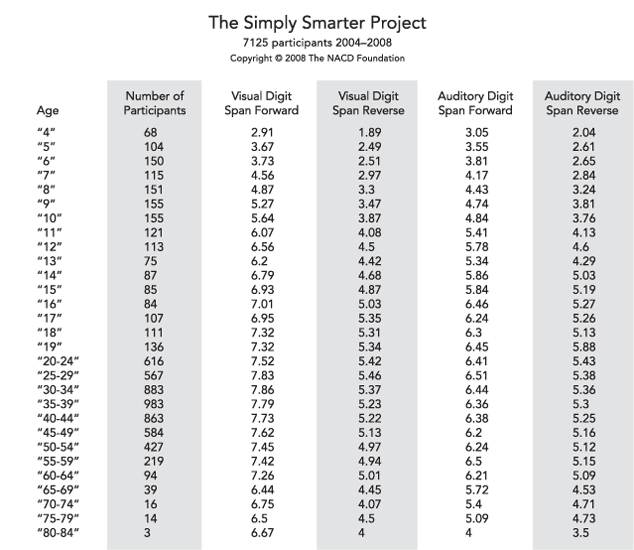The Effect of the Simply Smarter Program on Short-Term Memory, Working Memory, and Academic Competency for Elementary Students
by Robert J. Doman, Jr. and W. Bruce Haslam, Ph.D.
This study was conducted by The National Association for Child Development (NACD) during the 2011/2012 school year within a public elementary school in Northern Utah. With the approval of the principal the program was implemented by one of the teachers, who had the target classroom implement the Simply Smarter program. The program was used for a short period, beginning in January 2012 and continuing until mid-May 2012. Despite the short period of the study, results showed improvement in the individual students’ sequential processing levels, or digit spans, reflecting improvement in short-term and working memory. There was also a relationship between digit spans and academic scores.
The Simply Smarter program was done daily within the classroom, generally involving a 10-15-minute session per child. In each session the students completed five activities. The first game-like activity was an intensity activity designed to increase focus prior to working on the individual processing activities. There were two auditory processing activities: Auditory Forward (AF) digit spans and Auditory Reverse (AR) digit spans. There were also two visual processing activities: Visual Forward (VF) digit spans and Visual Reverse (VR) digit spans. The program is designed to provide the user with an initial baseline score that indicates current processing ability in the various activities. As the user does the program, it responds to the user’s scores and raises or lowers the difficulty level of the activities. Auditory Forward digit spans are considered a measure of short-term memory, and Auditory Reverse digit spans are considered a measure of working memory.
The public elementary K-6 grade school in which this study was conducted is considered an “inner-city” school and had the following demographics, as of 2009: More than 80% of the student population is considered a minority. More than 80% of the student population is on a reduced or free lunch program. In addition most students in this school speak English as a second language and come from disadvantaged homes.
The target classroom was an upper grade elementary class. A total of 22 students participated in this school study. As stated the study was initiated at the beginning of January 2012. The children participated in the online program daily from the beginning of January through the first two weeks of May. The teacher provided a reinforcement program for improvement in scores for each student.
Looking at the target class overall, there were statistically significant gains in the students’ digit span scores from January through May. In the four main Simply Smarter activities that all students participated in, the improvements were as follows:
Mean scores for 22 students:
Auditory forward digit span went from 5.18 to 7.52, an improvement of 2.34 digits.
Auditory reverse digit span went from 3.95 to 6.88, an improvement of 2.93 digits.
Visual forward digit span went from 5.73 to 7.66, an improvement of 1.93 digits.
Visual reverse digit span went from 3.85 to 6.79, an improvement of 2.94 digits.
If we compare these increases with data collected from the Simply Smarter Project (the international initiative that collected data on processing skills of 7125 individuals) (Table 1), the improvements are very dramatic. Scores for 10 to 11 year old children in the Simply Smarter Project showed the following growth in a year:
Auditory forward digit span – 0.57 digits
Auditory reverse digit span – 0.37 digits
Visual forward digit span – 0.46 digits
Visual forward digit span – 0.21 digits
As can be seen, the improvements in digit span scores of the students in the school study far surpassed what would be expected just from the passage of time and normal maturation.

The students were tested by the school using the MAPS – Measure of Academic Progress for Primary Grades. All children were tested in the fall, winter, and spring. Correlations were computed between digit span values in May and the May scores on the MAPS test. Correlations indicate the relationship between two variables, the tendency for scores on one variable to be associated with values on the other variable. The highest possible correlation is 1.00. Values above 0.54 show a strong correlation. Correlations above about .30 show a moderate relationship where correlations can be used to predict what MAPS scores would be. The correlations are indicated below:
AF and Language 0.58
AF and Reading 0.54
AF and Math 0.39
AF and Science* 0.34AR and Language 0.65
AR and Reading 0.54
AR and Math 0.59
AR and Science* 0.29VF and Language 0.46
VF and Reading 0.47
VF and Math 0.56
VF and Science* 0.32VR and Language 0.47
VR and Reading 0.45
VR and Math 0.26
VR and Science* 0.28
*Note: The students received minimal science instruction in the classroom during this period of time.
Summary
The Simply Smarter Program was used by a public school classroom located in an underprivileged community in Northern Utah from January through mid-May of 2012.
Following the trial period the target group showed significant improvement in Auditory and Visual Forward and Reverse Digit Spans, which are measures of short-term and working memory. Strong or moderate correlations were found between digit spans and MAPS test scores, indicating a significantly positive relationship between digit spans and academic scores as well.
The results of the study suggest that the Simply Smarter Program can be an effective tool for increasing short-term and working memory and may be used to increase reading and math scores.





